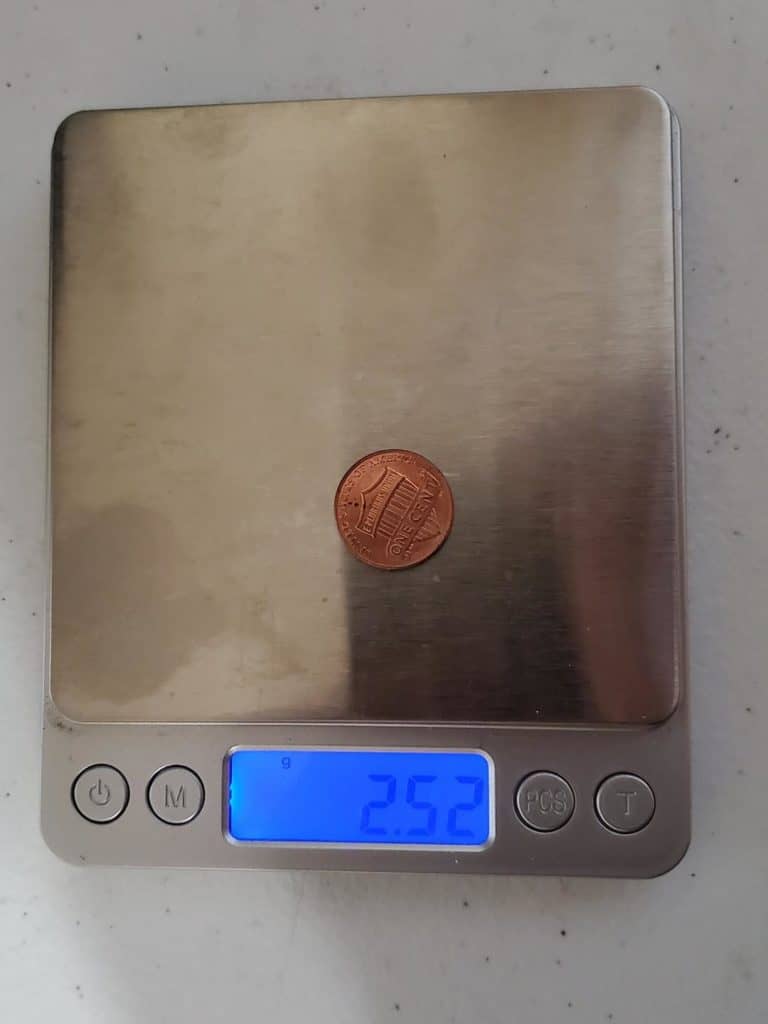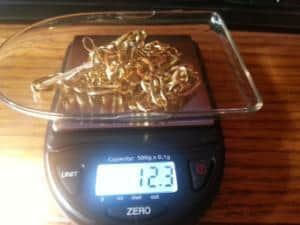Knowing the weight of your gold is going to give you an advantage when it comes time to sell.
What is the best way to weigh your gold, silver, or other precious metals? In most cases, you can weigh your precious metals on a kitchen scale or jewelry scale that will measure at least one decimal place. Next step is to turn on your scale, make sure it reads “0” and set your unit of measurement in grams. Place your items on the scale and you have the measurement.
There are several different units of measurements that are available on most scales but the most common units used when pertaining to jewelry are grams, troy ounces, and pennyweights.
One thing to note about when you choose ounces for your unit is that a troy ounce (31.1 Grams) is not the same as a standard ounce (28.34 Grams). To avoid confusion, it is best to stick with grams.
Although some jewelry stores use pennyweights, I find it easiest to stick with grams because that is generally the universal measurement for gold.
If you don’t own a scale
If you don’t have a scale at home, they cost about $10 to buy online. If you don’t want to purchase one, most post offices will gladly weigh your items for you if you are comfortable bringing your items inside the post office. As a reminder, if they give you ounces it is probably not troy ounces so you will have to convert the weight. If they give you a weight by ounce you are going to want to convert it to grams by taking the ounce weight times 28.34 which will convert your regular ounces to grams.
Simple Way To Weigh Gold
Place your scale on a stable surface. Turn on your scale and make sure it is weighing at zero. If it is not weighing zero, there should be a setting to zero it out. Make sure nothing else is touching the scale and place your item on the scale. When you place your item on the scale eventually the numbers will stabilize and you will then want to record the unit in grams to the nearest decimal point.

If you are unsure that your scale is reading correctly, you can weigh a penny on the scale and the numbers should match. Keep in mind that different years of pennies have different weights.
Here are the weights of pennies by year:
1864 to 1942 – ( 95% copper, 5% zinc tin ) 3.11 Grams
1944 to 1981 ( 95%) and zinc 5%) – 3.11 Grams
1982 to Present (copper plated zinc) 2.50 Grams
If your item is larger than the scale, you can use the cover as a tray to expand the scale size. To do this you first turn on the scale, and then place the tray on the scale which will then show the weight of the tray. You then hit the “zero” button once, and it should appear as “0” weight on the display to cancel out the weight of the tray on the scale. Your item is now ready to be weighed.

Phone apps for digital scales
A smart phone can pretty much do anything these days. Since they have came out it seemed possible at some point for someone to invent an app that you could use for a digital scale. After checking about once a year for the past 10 years, there still is not a trustworthy app scale out there.
These apps are all full of ads and don’t work well at all and there are around 20 apps to install to test, and none of them work at all.
Many of them are also full of ads and have fake reviews to make people think that they work. After doing some digging, I have yet to find one that reads accurately. I will be monitoring these apps from time to time, because I think it is definitely possible to produce an accurate scale, it just hasn’t been done yet. We will update this and do a post if and when this type of app becomes available.
Large Scales vs Small Scales
The advantages of using a larger scale vs a smaller scale might be obvious but there are a few tidbits we would like to elaborate on.
Larger jewelry scales can fit larger and heavier items on them. They range from 5kg to 30kg which can be useful if you are weighing heavy items. The also often have a battery option and a plugin option just in case your backup battery fails.
The price of a larger scale can be anywhere from $100 – $300 depending upon the scale. In most cases, you will not need to purchase a large scale and a smaller scale will be just fine. If your items are too large for a small scale it will read “error” and will be an indication that your items are too heavy.